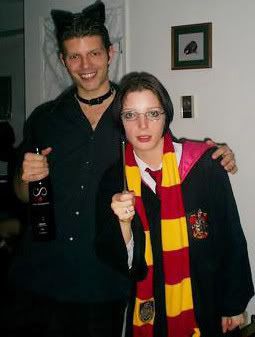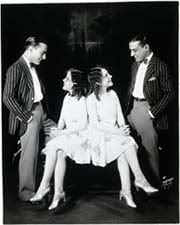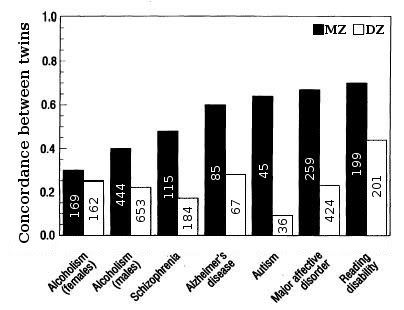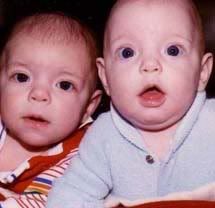Since my brother, Tim, and I recently shared our 22nd birthday I thought it would be relevant to talk about twins. Here is a photo of us at our birthday/Halloween party (I’m Harry Potter and I believe he is a Tom-cat, although whether or not the merlot is a part of the outfit I can only guess).

The first thing people assume when I say I have a twin is that we are identical, but as you can tell from the photo, we certainly aren't! Despite being twins, Tim and I don't have a lot in common even at the basic level of our biochemistry (he eats like a horse while I eat like a mouse, I get sick fairly often while he has a robust constitution). I am proud to say though that he is also an active part of the scientific community. He is currently doing research for the psychology department here at the University of Idaho.
So how can we be so different if we are indeed twins? Well, there are basically two types of twin--monozygous and dizygous. Dizygous twins (also called fraternal twins), like my brother and I, arise when two different eggs are implanted in the uterine wall and are fertilized by two different sperm. These types of twins share only as much genetic material as your regular sibling, they just happen to be gestated together. The capacity to have dizygous twins is heritable, so I may very well have twins myself.
 Monozygous twins, commonly known as identical twins, occur when only one egg implants in the uterine lining of the mother. That same egg is fertilized by only one sperm. The egg then splits into identical cells, which develop into genetically identical fetuses. Depending on when the egg splits, the twins may or may not share a placenta. If the egg splits relatively late in development (around 9-12 days post fertilization), mirror twins may result. These twins appear to be mirror images of one another, with the left features occuring on the right of the other and vice versa. If the egg does not begin to divide until 13 days post fertilization, the phenomena of conjoined twins (sometimes called "Siamese twins") may occur.
Monozygous twins, commonly known as identical twins, occur when only one egg implants in the uterine lining of the mother. That same egg is fertilized by only one sperm. The egg then splits into identical cells, which develop into genetically identical fetuses. Depending on when the egg splits, the twins may or may not share a placenta. If the egg splits relatively late in development (around 9-12 days post fertilization), mirror twins may result. These twins appear to be mirror images of one another, with the left features occuring on the right of the other and vice versa. If the egg does not begin to divide until 13 days post fertilization, the phenomena of conjoined twins (sometimes called "Siamese twins") may occur.Monozygous twins may be the same genetically speaking, but environmental differences ("nurture") could potentially begin as early as the womb as inequity in blood supply or differences in the way they are situated in the uterus may have an effect. Environmental differences continue to have a huge impact after birth as the children grow. Most monozygous twins (certainly the ones I knew growing up) become easier to tell apart both by personality and appearance as they age because they are exposed to different environments. The likelihood of having monozygous twins is not considered to have any strong genetic or ethnic link.
Speaking of genetic links, twin studies are the most widely used method of determining the heritability of human traits (who knows, twin studies may even be used to determine the heritability of having twins). Heritability is the proportion of phenotypic variance that is due to genetic variance. The equation is H^2 = 2 (rMZ-rDZ), where H^2 is heritability, rMZ is the proportion of monozygous twins sharing the trait and rDZ is the proportion of dizygous twins sharing the trait. Concordance is also used to give us an idea of how heritable a trait is. Concordance is how likely it is for a twin to share a trait with their twin sibling and is determined by the equation C/(C+D), in which C is the number of concordant pairs and D is the number of discordant pairs. Below is a sample graph of a concordance study:

Since the twins in the studies were raised in similar environments at similar ages, the primary factor that accounts for the variance between them is genetic. If the amount of dizygous twins sharing the trait is much lower than the amount of monozygous twins, then the trait is considered to be heritable. These studies can only give us an idea of what the heritability may really be as environment can never be fully ruled out in the complicated lives as humans.
Huge databases of registered monozygous twins and dizygous twins are made in an attempt to reduce the likelihood of chance affecting the studies. My brother and I are actually participants in the University of Washington twin registry. They send us surveys about once a year with questions about our diets, habits, mental and physical health, and behaviors. Since we are brother/sister twins, our data cannot be used in studies of traits that are thought to be sex-linked, like alcoholism, but are useful to studies that sex is an unimportant factor in, such as the heritability of myopia.
As many as 1 in 8 pregnancies start out as twins (or triplets or greater), but it is rare for the all offspring to survive; many die at very early developmental stages and some die later, due to issues such as the umbilical entanglement in instances where the placenta is shared. I feel considerably fortunate that I was able to make it, considering that my brother would probably have been the likely heavy weight champion if something had gone wrong.
I guess the second most common question I get asked about being a twin is if I like it. I’d say yeah, it’s pretty cool having a twin.

Images:
Concordance graph: wikipedia
Conjoined twins: http://www.wellcome.ac.uk/en/medicineman/understanding6.html
Photos of Tim and I taken by Jen and my mom
Informatin:
http://7e.devbio.com/article.php?id=111
Wikipedia
Barrie Robison, genomics instructor


3 Comments:
(it's robbie)
awww very cute little ending there.
By Anonymous, at 1:09 PM
Anonymous, at 1:09 PM
I found ure Genetics exp. v. helpful for my Human Genetics Assignment. Thanks. G. luck in your studies...
By cpcmfan, at 12:05 PM
cpcmfan, at 12:05 PM
Hey! I'm just a random. Was looking up differences between dizygous and monozygous twins and your blog made it so easy to understand! Thanks a bunch =)
I wish I had a twin!
By Anonymous, at 12:16 AM
Anonymous, at 12:16 AM
Post a Comment
<< Home